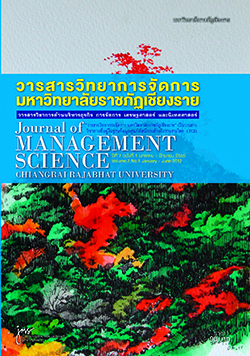Marketing Strategies of Alcohol Business in Thailand : A Case Study of Below the Line Strategies
Main Article Content
Abstract
The intention of the Thailand Alcohol Beverage Control Act B.E. 2551 (2008) is to protect young children and adolescents, especially from the attractive alcohol marketing communication tools. But there is evidence that shows the alcohol industry develop the marketing strategies to comply with the Code and lend many opportunities to circumvent the existing regulations. The method employed for this study comprised content analysis and ethnographic research by surveying and analyzing actual marketing events organized by the alcohol beverage companies. This included studying entertainment venues, pubs and bars located in city red and yellow zones situated around Rajabhat University campuses located in the Bangkok metropolitan area. The results showed that the alcohol beverage companies’ special Below the Line marketing activities fell under three classifications: 1. Pull Strategies aim at attracting customers to buy and drink alcohol products visit retailers and also all trade channel. 2. Push Strategies focus on the distributors, to encourage them to push the sale of alcohol beverages. And 3. Profile Strategies emphasize the companies’ Corporate Social Responsibility (CSR). The survey of the data relating to the entertainment venues, pubs, and bars revealed that Rajabhat students did not like to travel far to find entertainment and would look for venues within the university neighborhood. The venues’ decorations and atmosphere fall under ‘place strategy’. When surveying ‘price’ and ‘promotion’, it was found the prices were relatively inexpensive and mixers will be sold for less expensive prices than at other entertainment venues, and these prices will be announced at the front of the venues using large posters, signs and banners.
Article Details
Views and opinions expressed in the journal do not necessarily reflect those of the editors.
References
กนิษฐา ไทยกล้า. (2550). การศึกษาเปรียบเทียบความชุกและพฤติกรรมการดื่มของ นักเรียนนักศึกษากับความหนาแน่นของสถานที่จำหน่ายเครื่องดื่มแอลกอฮอล์ ในรัศมี 500 เมตร รอบสถานศึกษา.กรุงเทพฯ:ศูนย์วิจัยปัญหาสุรา (ศวส.). กฤตนี ณัฏฐวุฒิสิทธิ์ (2554). Marketing Panorama การตลาดมุมกว้าง. กรุงเทพฯ: หนังสือพิมพ์กรุงเทพธุรกิจ Bizbook. เกษม พิพัฒน์เสรีธรรม. (2552).การสื่อสารการตลาดแบบบูรณาการ. (ออนไลน์). แหล่งที่มา advisor.anamai.moph.go.th/conference/2548/IMC.ppt ธีรพันธ์ โล่ห์ทองคำ. (2548). กลยุทธ์การสื่อสารการตลาดแบบครบวงจร. กรุงเทพฯ: ทิปปิ้งพอยท์. นุวีร์ เลิศบรรณพงษ์. (2549). กลยุทธ์การบริหารแบรนด์พอร์ ตโฟลิโอ. กรุ งเทพฯ แบรนด์เอจ; 2549. โทมัส บาร์เบอร์และคณะ. (2553). แปลและเรียบเรียงโดย ทักษพล ธรรมรังสีและคณะ ศูนย์วิจัยปัญหาสุรา. สุราไม่ใช่สินค้าธรรมดา. กรุงเทพฯ: ศูนย์วิจัยปัญหาสุรา (ศวส.). ปุญชรัศมิ์ หนูทอง. (2549). กลยุทธ์การสื่อสารเพื่อรับมือกับนโยบายการห้ามโฆษณาเครื่อง ดื่มแอลกอฮอล์: ศึกษากรณีเฉพาะบริษัทริชมอนเด้ (บางกอก)จำกัด. (สารนิพนธ์). กรุงเทพฯ:คณะวารสารศาสตร์และสื่อสารมวลชน มหาวิทยาลัยธรรมศาสตร์. พจน์ ใจชาญสุขกิจ. (2550). พลิกโฉมองค์กรด้วยกลยุทธ์การสื่อสารชั้นเซียน. กรุงเทพฯ: ฐานบุ๊คส์, เพ็ญนภา มงคลนิตย์. (2549). กฎหมายการโฆษณาเครื่องดื่มแอลกอฮอล์กับการจัดกิจกรรม พิเศษของเครื่องดื่มแอลกอฮอล์ : กรณีศึกษา : งานเปิดตัวเครื่องดื่มแอลกอฮอล์ "Reserve brand" [สารนิพนธ์]. กรุงเทพฯ: คณะวารสารศาสตร์และสื่อสาร มวลชน มหาวิทยาลัยธรรมศาสตร์, มิ่งมงคล ทวีกุลวัฒน์. (2545). กลยุทธ์การสื่อสารการตลาดแบบผสมผสานของตราสินค้า "ไทเบียร์ ". (วิทยานิพนธ์โครงการพิเศษ). กรุงเทพฯ: คณะนิเทศศาสตร์ จุฬาลงกรณ์มหาวิทยาลัย.
เมธา ฤทธานนท์. (2550). การตลาดฉบับคอตเลอร์. กรุงเทพฯ:แบรนด์เอจบุ๊คส์. สิทธิ์ ธีรสรณ์. (2551). การตลาด จากแนวคิดสู่ การปฏิบัติ. กรุงเทพฯ: สำนักพิมพ์ แห่งจุฬาลงกรณ์มหาวิทยาลัย. อลิศรา พิริยโสภากุล. (2547). การจัดกิจกรรมการตลาด (event marketing): เครื่องมือของ below the line ที่ขาดไม่ได้ในยุคปัจจุบัน. (สารนิพนธ์). กรุงเทพฯ: คณะวารสารศาสตร์และสื่อสารมวลชน มหาวิทยาลัยธรรมศาสตร์. อิศราภรณ์ อนวัชชสุข. (2549). การโฆษณาเครื่องดื่มที่มีส่ วนผสมของแอลกอฮอล์ [สารนิพนธ์]. กรุงเทพฯ: คณะวารสารศาสตร์และสื่อสารมวลชน มหาวิทยาลัย ธรรมศาสตร์, เอกชัย อภิศักดิ์กุล. ยุทธศิลปะ CSR Strategies. นิตยสาร Strategy+Marketing Volume 7 Issue 079: 68-70.
ภาษาอังกฤษ
Christopher Martinetal. (1972). Marketing below-the-line. London: Georrge Allen & Unwin Ltd. Fill, Chris. (2005). Marketing communication: contexts, strategies, and applications. ESSEX:Pearson Education. Gunter, Barrie et al. (2010). Alcohol advertising and young people’s drinking: representation, reception and regulation. NY:Palgrave Macmillan. Lancaster, G. & Reynolds,P. (1999).Introduction to marketing: a step-by-step guide to all the tools: UK, KoganPage Limited.


